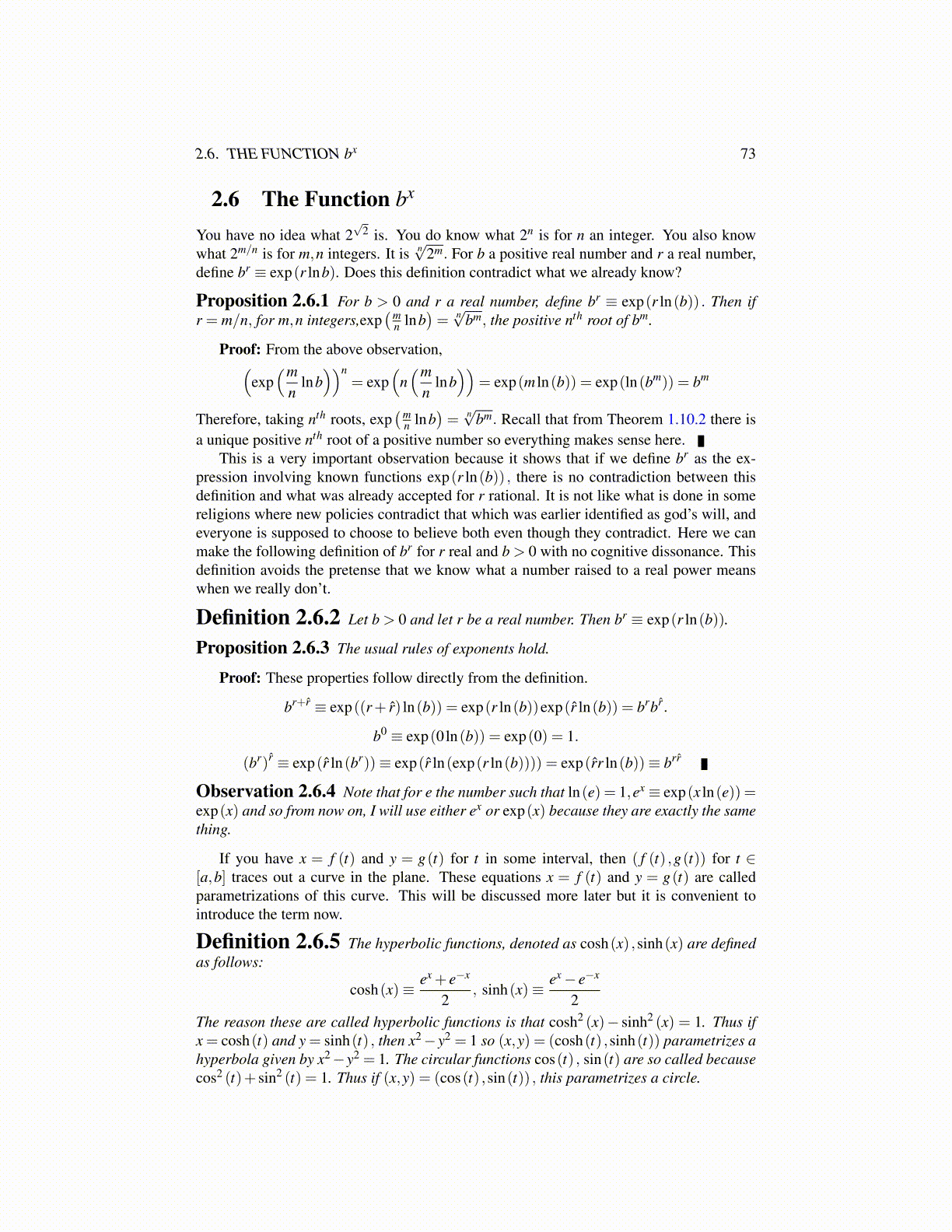
2.6. THE FUNCTION bx 73
2.6 The Function bx
You have no idea what 2√
2 is. You do know what 2n is for n an integer. You also knowwhat 2m/n is for m,n integers. It is n
√2m. For b a positive real number and r a real number,
define br ≡ exp(r lnb). Does this definition contradict what we already know?
Proposition 2.6.1 For b > 0 and r a real number, define br ≡ exp(r ln(b)) . Then ifr = m/n, for m,n integers,exp
(mn lnb
)= n
√bm, the positive nth root of bm.
Proof: From the above observation,(exp(m
nlnb))n
= exp(
n(m
nlnb))
= exp(m ln(b)) = exp(ln(bm)) = bm
Therefore, taking nth roots, exp(m
n lnb)= n
√bm. Recall that from Theorem 1.10.2 there is
a unique positive nth root of a positive number so everything makes sense here.This is a very important observation because it shows that if we define br as the ex-
pression involving known functions exp(r ln(b)) , there is no contradiction between thisdefinition and what was already accepted for r rational. It is not like what is done in somereligions where new policies contradict that which was earlier identified as god’s will, andeveryone is supposed to choose to believe both even though they contradict. Here we canmake the following definition of br for r real and b > 0 with no cognitive dissonance. Thisdefinition avoids the pretense that we know what a number raised to a real power meanswhen we really don’t.
Definition 2.6.2 Let b > 0 and let r be a real number. Then br ≡ exp(r ln(b)).
Proposition 2.6.3 The usual rules of exponents hold.
Proof: These properties follow directly from the definition.
br+r̂ ≡ exp((r+ r̂) ln(b)) = exp(r ln(b))exp(r̂ ln(b)) = brbr̂.
b0 ≡ exp(0ln(b)) = exp(0) = 1.
(br)r̂ ≡ exp(r̂ ln(br))≡ exp(r̂ ln(exp(r ln(b)))) = exp(r̂r ln(b))≡ brr̂
Observation 2.6.4 Note that for e the number such that ln(e) = 1,ex ≡ exp(x ln(e)) =exp(x) and so from now on, I will use either ex or exp(x) because they are exactly the samething.
If you have x = f (t) and y = g(t) for t in some interval, then ( f (t) ,g(t)) for t ∈[a,b] traces out a curve in the plane. These equations x = f (t) and y = g(t) are calledparametrizations of this curve. This will be discussed more later but it is convenient tointroduce the term now.
Definition 2.6.5 The hyperbolic functions, denoted as cosh(x) ,sinh(x) are definedas follows:
cosh(x)≡ ex + e−x
2, sinh(x)≡ ex − e−x
2The reason these are called hyperbolic functions is that cosh2 (x)− sinh2 (x) = 1. Thus ifx = cosh(t) and y = sinh(t) , then x2 −y2 = 1 so (x,y) = (cosh(t) ,sinh(t)) parametrizes ahyperbola given by x2−y2 = 1. The circular functions cos(t) , sin(t) are so called becausecos2 (t)+ sin2 (t) = 1. Thus if (x,y) = (cos(t) ,sin(t)) , this parametrizes a circle.